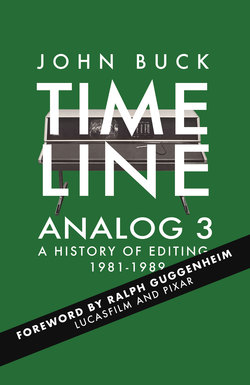Читать книгу Timeline Analog 3 - John Buck - Страница 12
На сайте Литреса книга снята с продажи.
EPIC
ОглавлениеThe EPIC system was now owned by Harris Corporation.
Loran Kary lead EPIC's software engineering when the Walt Disney Company's research division, WED (Walter Elias Disney) Enterprises expressed an interested in using EPIC for film editing. David Spencer and Richard Barns from WED needed a way to edit millions of feet for promotional films for Disney's EPCOT Experimental Prototype Community of Tomorrow. Disney wanted EPCOT to stimulate American industry to develop new ideas for urban living. Kary recalls:
Instead of the normal way of cutting their film projects on a film flatbed they wanted to know if it was possible to transfer the film to videotape, cut on videotape and then use a list to cut the film using edge numbers. I worked with the market leaders in timecode devices, Grey Engineering Laboratories to develop such a system.
They developed the hardware that interfaced with the film transfer chain and then could read the edge code numbers off the telecine and encode them into the U-bits of the videotape copy's VITC.
This was very advanced technology for those days and then of course you needed another piece of equipment that would extract the film information from the VITC in real time while you were editing. When you were complete it would help you automatically create a film cut list for the negative cutters
Standard SMPTE code was not capable of finding events below the frame rate that it had been originally designed for. Kary and the Grey Engineering team created a new approach for the EPIC that they labeled ‘field-rate’ timecode. In order to solve the impasse they doubled the frequency of the timecode itself and by doing so removed the ambiguity between 24fps film and 30fps video.
Meanwhile the CFI team experimented with editing on videotape in tandem with television programs edited natively on film. The hit TV show Magnum P.I. was posted at CFI and served as a test for the Film 5 system. Schneider recalls how the unique test was organized.
Universal Studios made a black and white duplicate of the original Magnum film footage, as well as the magnetic sound track. We took the episode and ran it through the Film 5 process to compare with their standard film procedures.
Magnum's editor cut on a Moviola while Schneider used Mach One:
Their editing time to first cut was 135 hours, compared to my 69 hours with videotape.
During the development Kravits, Schneider and Dan Brewer experimented with the feasibility of editing videotape at 24fps to eliminate the 24 to 30 frame conversion problem which they outlined in a SMPTE journal of the day. Kravits recalls:
Except for the inconvenience of having to view these tapes on specially converted VTRs, the inherent frame accurate cut lists generated by this 24 frame system open up a new potential for a simplified editing system. It was about then I started to notice the film editors working on Moviolas and I started to take note of how they worked, the old fashioned way of using a cutting table and you could see this was a long and convoluted process.
CFI’s President Tom Ellington asked me “Can you develop some kind of a system in which these film editors who are very electronic phobic, can really understand and work in an electronic environment”. I studied them and realized how tactile a craft that it was, they worked by hand
Across at Harris, the EPIC system was used to edit the EPCOT rear projection projects including American Adventure but the entire project was abandoned.
Loran Kary knew that the methodology would eventually find a technology to fit and he wrote a paper (Coincidentally at the same time as Schneider and Kravits) describing the system in his SMPTE paper.
It was way ahead of its time and probably unrealistic because of a number of reasons. One was its cost; it was very expensive. Film editors were accustomed to working on a flat bed or a stand up Moviola system in a nonlinear way on a system that they rented for $100 a month. Secondly the new EPIC required all this electronic equipment that required all these engineers to maintain it.
Compared with a film editing system, which had negligible cost and just worked, it didn't have a whole bunch of electronics that were breaking down all the time or you couldn't understand what it was doing and some new interface you had to learn. But the most critical reason was the fact that it was linear. I mean if you made a mistake using video you had to stop and go back re-assemble from that point on. It was just unthinkable at that time.
